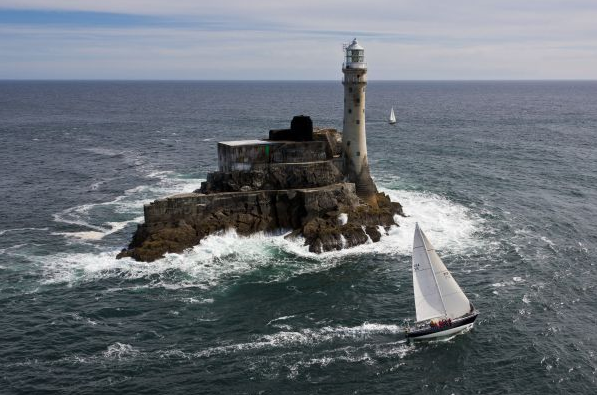How the iconic offshore race smashes its own record eight months before the start
It took just 24 hours to sell out all 300 places for this year’s Fastnet race – a new record before the race has even started. But this is no flash in the pan, the last race in 2011 was so popular that additional places were made available and saw a record 314 starters.
“We were pretty impressed in 2011 when we sold out in 10 days after opening entries, but this has just blown us away,” said RORC racing manager Nick Elliott.
The sell out is certainly impressive and flies in the face of a common mis-perception, particularly in the professional world, that yacht racing is in crisis. Sure, events from the Volvo, to the America’s Cup and even the Vendee Globe are struggling to hit their target fleet sizes, but this should not be confused with the general sailing fraternity’s desire to go racing.
Having said that, some of the popular regattas are suffering and a long way off their previous best. This year’s Sydney Hobart saw just 76 starters, down on the previous race in 2011 and a long way off its biggest ever entry of 371 starters for the 50th anniversary race in 1994. Cork Week and Key West are also facing significantly smaller fleet sizes than in their heyday.
So why is the Fastnet race, with its notorious reputation and its time consuming regulations on crew qualifications, so successful when other events and regattas around the world are struggling to maintain their fleet sizes?
“The Fastnet race has become iconic in offshore racing and there’s clearly an attraction in that,” said Elliott. “The race is seen as a big challenge and simply competing in it draws a lot of interest.
“The event also fits within a week which is easy for people to plumb into their calendars. The location of the race means that it is in the centre of a large catchment area where a large pool of boats can get to and from the race easily. Many are within 12-24 hours of the start and finish areas, so in that respect it’s an easy race to take part in, compared to some of the distances that say Australian boats have to travel to compete in the Sydney Hobart race.”
Even so, the international element is another impressive feature of this race with entries coming from 20 countries, many of them sailing to the UK to compete.
But the Fastnet race is about more than just the race itself, it’s about the journey, the programme and the attraction of working towards a season goal and the sense of achievement that follows such a commitment. The fact that there are crew qualification requirements means that signing up to a season of racing is more likely and easier to justify to yourself, your family and your bank manager. The ability to buy a berth aboard a professionally run school or charter boat provides another draw to the event.
“The pay-to-play element is an important one and not solely for the Fastnet race” continued Elliott. “To buy a place on one of these campaigns that will include say the three necessary qualifying RORC races plus some training, might cost say £3,000. You can’t even buy a marina berth for that.
“This also means that other events in our calendar like the Morgan Cup and St Malo race among others are particularly well supported in Fastnet years.”
From this you might deduce that the commercially run campaigns for amateur sailors are bolstering the event and providing the lion’s share of entries. But you’d be wrong. Commercial entries account for just 8-10 percent according to Elliott. The remainder are from private entries.
Given the high profile of this event and the glamourous boats that regularly steal the line honours and headlines, the type of boats that make up the bulk of the fleet is also surprising. Around 80 percent are boats around 40ft LOA. Beneteau 40.7s, J109s, Sigma 38s, Prima 38s and others of a similar ilk are by far the most popular boats.
Yet there is also a growing trend in the way that people are competing with a growing interest in shorthanded sailing.
“This is an area that’s definitely growing,” said Elliott. “I think we will see more than 30 boats in this category which would be our biggest entry.”
Over Christmas, while watching the progress of the Sydney Hobart race fleet and talking to friends who had competed in ‘ordinary’ boats, I began to wonder if one of the problems of long distance offshore races was the huge spread in finishing times between the modern greyhounds and the production plodders. By the time the latter group finish many of the big boats and their teams have left and the buzz has subsided. I’ve heard people say the same about the Fastnet, which led me to wonder whether offshore races like these should be run as a pursuit race instead.
Starting the slow boats off first and the fastest last could create a spectacular finish. The trouble is that Plymouth would struggle to cope with a sudden influx of 300+ boats. Indeed one of the key reasons that the RORC allowed more boats than the original 300 boat limit was that the additional boats were significantly faster than the bulk of the fleet and would be over the line and on their way home before the main fleet arrived.
The reality is that a 24 hour sell out suggests that there is little, if anything, wrong with the format of one of the world’s most famous races. There must surely be lessons to be learned from this popular format that might help other events.
The bottom line is that the Fastnet has become sailing’s Glastonbury or Olympics – you’ve got to be very quick to get in.




